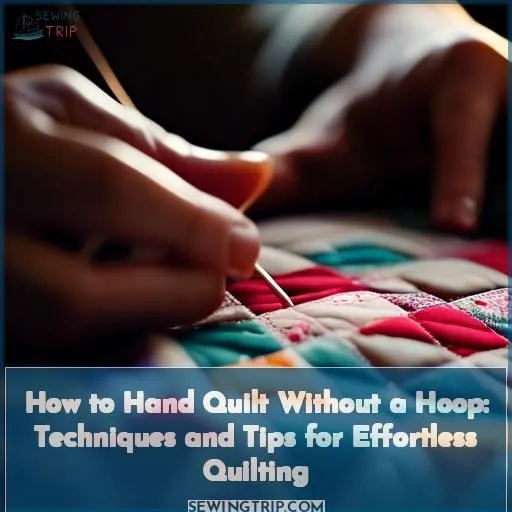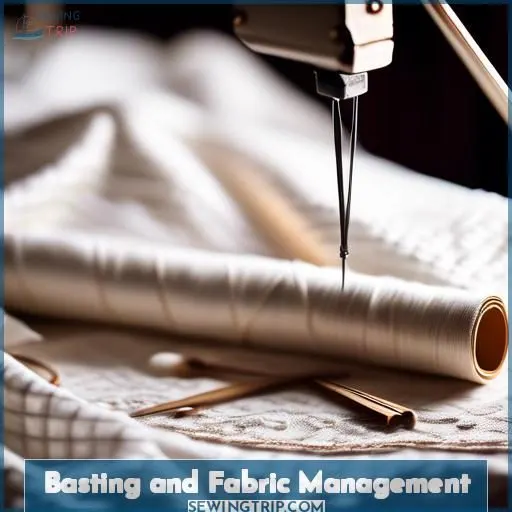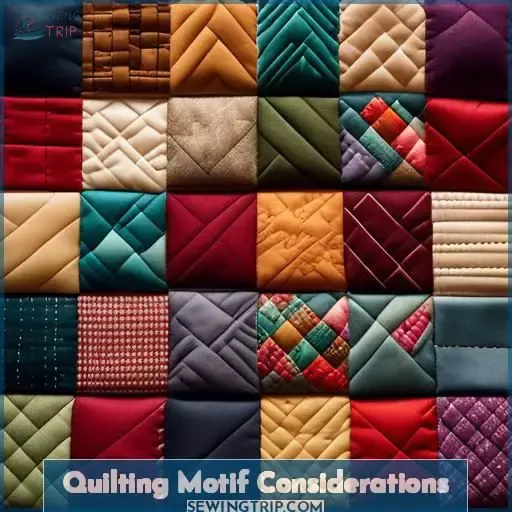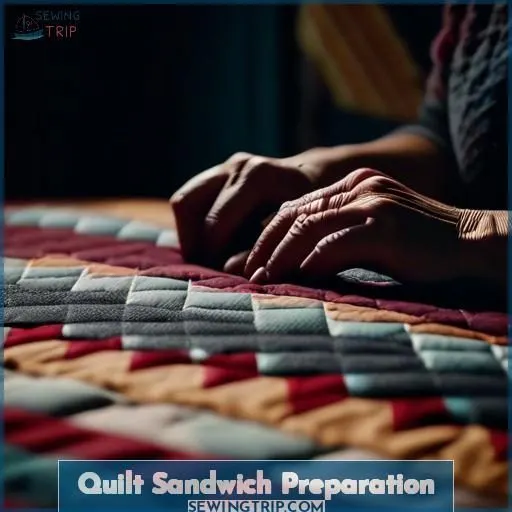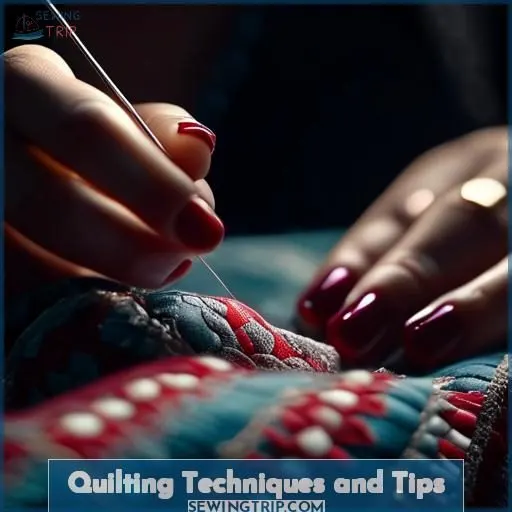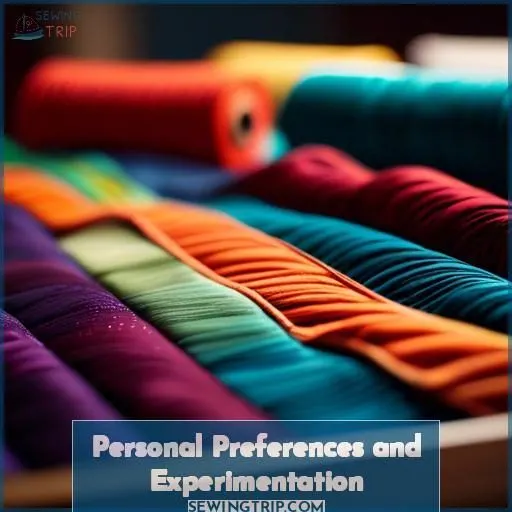This site is supported by our readers. We may earn a commission, at no cost to you, if you purchase through links.
You’ll effortlessly hand quilt without a hoop by mastering fabric manipulation.
Baste the quilt sandwich firmly, keeping the backing smooth and twist-free.
Choose simpler motifs for fluid needle motion and even stitch size.
Maintain balanced tension – not too loose or tight – for consistent stitches per inch using sharp needles and waxed thread.
Comfort is key; consider Georgia Bonesteel’s hoop-less techniques, portability needs, and your quilting frequency.
Personal preference guides motif selection and whether to use a Q-snap frame for added support.
Experimentation reveals the techniques best suited to your quilting style.
Table Of Contents
Key Takeaways
- Master fabric manipulation to maintain balanced tension and ensure even stitch size.
- Choose simpler motifs for fluid needle motion and ease of stitching.
- Experiment with different basting methods and fabric management techniques.
- Personal preference plays a significant role in selecting quilting motifs and techniques.
How to Hand Quilt Without a Hoop?
To hand quilt without a hoop, you can use the Sharon Schamber board method to baste your quilt and then stitch with small, even stitches.
Baste the quilt with thread about a hand’s width apart to prevent layers from shifting.
Start with six stitches per inch and use a pencil, tailor’s chalk, or other marking tools to draw your thread path.
Push the loose fabric onto the needle to create clean-looking, professional quilts.
Load your needle with up to three stitches at a time before pulling it through the layers to achieve beautiful and uniform stitches.
Basting and Fabric Management
To hand quilt without a hoop, you’ll need to focus on fabric management and tension control. Here are some tips:
- Needle choice: Opt for sharp needles, such as size 10 or 11, to guarantee smooth stitching and prevent fabric damage.
- Tension management: Keep the tension loose to allow for fabric movement and manipulation.
- Fabric manipulation: Use your hands to manipulate the fabric as you stitch, making sure a consistent stitch size.
- Comfort considerations: Choose a comfortable seating position and adjust your lighting to reduce eye strain.
- Portability benefits: Hand quilting without a hoop allows for greater flexibility and portability, making it easier to work on your quilt in different locations.
For basting, consider the following methods:
- Thread basting: Use contrasting thread and large stitches to temporarily hold the quilt layers together.
- Spray basting: Apply a thin layer of spray adhesive between the layers, allowing for easy removal once quilting is complete.
- Board basting: Pin the layers together using a board and pins, making sure a stable base for quilting.
- Machine basting: Use a sewing machine to baste the layers together, providing a secure foundation for hand quilting.
- Water solvable thread: Consider using water solvable thread for basting, making removal easier once quilting is complete.
Quilting Motif Considerations
When hand quilting without a hoop, your choice of quilting motifs can substantially influence the final appearance and comfort of stitching. Complex designs may be difficult, so think about choosing simpler motifs that permit smooth needle motion and even stitch size. In the end, your personal taste should direct your motif selection, ensuring a pleasurable and fulfilling quilting experience.
Hoop-less Hand Quilting
Hoop-less hand quilting is a technique that allows you to manipulate fabric freely without the constraints of a hoop. It’s a popular choice for those who prefer a more natural hold on their quilt or for those who find it more comfortable to work on a table rather than in their lap. This technique requires you to keep the back of the quilt smooth and free of twists, as there’s no hoop to hold the layers in place. Any basting method can be used, and you can even use a q-snap floor frame instead of a hoop for added support.
Fabric manipulation is key in hoop-less hand quilting. You can push the needle through the fabric layers, guide the remaining thread through until the knot goes underneath the quilt top, and cut the rest of the thread as closely to the fabric as possible to finish a line of stitching. This technique allows for fluid movement around or across the quilt, depending on your quilt motif, and permits the draping of the quilt for a more natural hold.
Personal preference plays a significant role in choosing between hoop-less hand quilting and traditional hoop quilting. Some quilters find that hoop-less hand quilting provides a more comfortable and relaxed experience, while others prefer the stability and control offered by a hoop. Experimentation with different techniques and tools is essential in determining which method suits you best.
Stitch Size and Appearance
Ditching the hoop doesn’t mean ditching precision. With the right hand grip and needle choice, you’ll master tension control, ensuring your stitches per inch remain consistent.
Think of fabric tension like a dance—too loose, and your stitch size wobbles; too tight, and it’s a tug-of-war.
A sharp needle and waxed quilting thread glide through fabric, making stitch placement a breeze.
Personal Preference
Personal preference plays a significant role in hand quilting without a hoop.
Comfort considerations, hand quilting frequency, and the instructor-led classes you’ve attended can influence your decision.
Portability and productivity are key factors in lap quilting, which is often preferred for its ease and flexibility.
Georgia Bonesteel’s popularized techniques, such as the noodle method and two board/swimming noodle method, offer alternatives to traditional hoop usage.
Ultimately, your personal experimentation and comfort level with different methods will determine the best technique for you.
Quilt Sandwich Preparation
Preparing a quilt sandwich is a critical step in hand quilting, regardless of whether you use a hoop or not. The sandwich comprises the quilt top, batting, and backing fabric. Here are some tips for preparing your quilt sandwich:
- Select the appropriate batting: Choose a batting type that aligns with your project. Cotton batting is often favored for hand quilting, as it’s easier to needle and doesn’t have small pieces pulling through the fabric. Polyester batting is also suitable for hand quilting, as it’s more fluffy and has a higher loft than most other types of batting.
- Basting: Basting is an indispensable part of quilt sandwich preparation. You can employ various basting methods, such as thread basting, spray basting, or pins. For hand quilting without a hoop, using pins may be more convenient.
- Fabric tightness: Confirm that the fabric tightness is uniform across the entire quilt sandwich. This will prevent puckering or folds in your finished quilt. You can achieve this by carefully stretching the backing fabric and smoothing the batting and quilt top.
- Quilt dimensions: Be aware of the size of your quilt. If you’re hand quilting, it’s imperative to take into account the size of your hoop or lap, as well as the size of your quilt top, batting, and backing fabric. Ensure that they’re all compatible and that you have sufficient space to work comfortably.
- Hand quilting without a hoop: If you’re hand quilting without a hoop, you may find it easier to begin in the center of your quilt and work towards the edges, rehooping in a circular pattern.
Quilting Techniques and Tips
- Loose Hoop Quilting Techniques: Rocking the fabric rather than the needle is common in loose hoop quilting. Use sharp needles (e.g., size 10 or 11) and maintain loose hoop tension to allow for fabric movement. In-hoop fabric manipulation is possible, and you can even decorate stitching without a hoop.
- Fabric Manipulation: Long needles and fabric manipulation are used in loose-hoop quilting. The Thimble lady’s YouTube video demonstrates this technique. Personal experimentation helps determine the best technique for hand quilting without a hoop.
- Clamps and Presser Feet: Clamps and sewing machine presser feet can assist with fabric management when hand quilting without a hoop.
- Tips for Effortless Quilting: Start quilting from the center, use basting thread instead of pins, secure the quilt with clips or pins, use a scrap of fabric under clips, and tilt the quilt forward for better visibility.
Personal Preferences and Experimentation
Personal preferences play a significant part in hand quilting without a hoop.
Comfort considerations, such as loose tension and lap quilting, can make the experience more pleasant.
Needle selection is vital, with sharp needles like size 10 or 11 suggested.
In-hoop manipulation allows for better control and accuracy.
Experimentation is essential to finding your favored technique, be it loose-hoop quilting or hand quilting on a floor stand.
Your personal preference ultimately decides the best method for you.
Conclusion
Ultimately, mastering how to hand quilt without a hoop boils down to experimentation.
Try different motifs, techniques, and setups to find what suits your quilting style best.
With practice, you’ll develop the fabric manipulation skills needed for effortless hoop-less quilting, achieving consistent stitches and balanced tension.
Embrace the portability and simplicity of this method, and let your quilting journeys take you wherever creativity flows.

